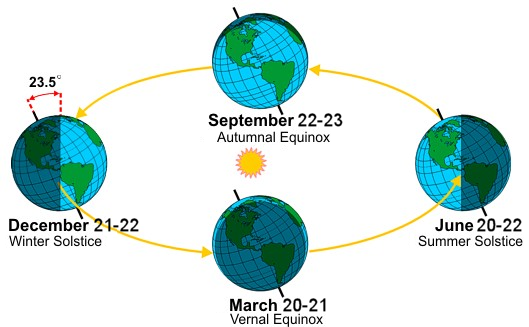One of the surprising things about teaching science is that you realize that most people don’t have a clue about what causes the seasons. They think that it’s winter when we’re farthest away from the sun…which makes sense until you realize that our CLOSEST approach to the sun is on January 5, in the very dead of winter in the Northern Hemisphere.
Today is semi-officially the autumnal equinox, the day that fall begins. I spent the morning looking through videos on YouTube to try to find one that accurately shows why the autumnal equinox is important, namely, why the day and the night are the same length all over the word (hence the name “equinox.” I finally gave up, and have posted instead the above diagram.
For whatever reason, many textbooks display the earth as rotating straight up and down, with its axis of rotation perpendicular to the plane of the orbit of the earth around the sun. In fact, the axis of rotation is tilted about 23.5° off of the vertical. Any good globe will reflect this inclination.
The axis of rotation does not vary much as the earth orbits the sun. (There are some long-term wobbles that over long periods of times for humans–about 26,000 years–have the axis pointing to a different “North Star,” and long-term but small changes in the angle of inclination are the probable reason for Ice Age, but for out purposes we can assume that the axis is fixed, leastwise during our own lifetimes.) This, in turn, means that the earth will be inclined toward the sun in the Northern Hemisphere between March and September, and the Southern Hemisphere will get its turn for summer between September and March.
The 3-D geometry of a sphere rotating at a 23.5° angle from the vertical is difficult to visualize even when you see it, and almost impossible to describe when you can’t. However, if you take a properly inclined globe and walk around a center light (like a lamp without the lampshade) and keep the axis of rotation pointed in the same direction, you’ll find two points where the axis is perpendicular to the line drawn from the lamp to the globe. If you look at the illumination of the globe at that point, you’ll see that lights up exactly half of the earth. The earth is still inclined (most animations make it go upright, which is wrong, wrong, wrong), but the figure above gets it right on both the autumnal and vernal (spring) equinoxes.
Another feature of the equinoxes is that the sun rises directly in the east and sets directly in the west. That’s why many ancient monuments like Stonehenge or the Maya temples are aligned on an east-west axis. It takes 100-200 years of living in a location to figure such things out. The Griffith Observatory in Los Angeles has lines embedded in the concrete so you can line up and see the sun rise directly in the east and set directly in the west. I actually saw something similar in 2007, my first year of teaching. I happened to be riding a bus along a stretch of the 10 freeway just to the west of downtown Los Angeles that I knew was laid out exactly east-to-west, and watched the sun come up in the middle of the road. For the next six months, it rose off to the right (i.e., to the south) and then returned in mid-March, where it rose to the north for the next six. Even modern people can occasionally duplicated the efforts of our ancestors!
In the Northern Hemisphere, our days will shorten and be shorter than the nights until thereabouts of December 22, which will be the shortest day of the year. At that point the sun will be as far to the south as it will get, and between December 22 and the spring equinox, will travel back until it again crosses the east-west line. After that, the days will again be longer than the nights for another six months. One way of looking at the equinoxes is that the next six months will either bring nights longer than the days (autumnal equinox) or days longer than the nights (spring equinox).
